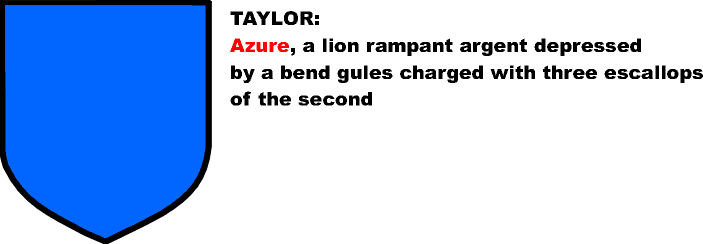
BLAZON OF ARMS: How a heraldic shield is compounded.
First, take a minute seeing this interesting animation where we could see the process of
elaboration of a heraldic shield based on their description.
Arms for Taylor:

BLAZON, or BLASON, is the proper technical description of Armorial bearings, according to
the scientific rules of heraldry. In Blazoning a coat of Arms, brevity is to be studied,
and tautology avoided, care being still taken to give a minute description of every
bearing, its position, place on the shield, tincture,etc. though the same metal, colour,
or fur may occur more than once, the repetition of its name should be scrupulously guarded
against, by describing the charge, which happens to be of a tincture already mentioned, as
of one of the first, second, or third, according to the relative position that tincture
may hold in the blazon; for example, the Arms of Preston of Furness Abbey are, argent two
bars gules on a canton of the second a cinquefoil or. In this blazon the colour of the
canton is described of the second to obviate the repetition of the word gules. The next
general rule to be observed is to begin the blazon with the description of the field, its
tincture, or tinctures, unless it is divided by any of the main partitions already
treated, in which case the descriptive blazon would begin as per fess, per pale, per
saltire, etc. The principal ordinary, if any should next to be described, with its
tincture, etc; and then the charges around it generally, giving the surcharges upon such
ordinary, after those between which it is borne; the chief canton, or any charge placed in
a particular point of the shield, with its surcharges, if any, being generally blazoned
last.
If a coat consists of two tinctures only, it is blazoned as in the arms of LAMBTON, Sable
a fess between three lambs passent argent. Which indicates that both the fess and lambs
are of the tincture argent; when the last-mentioned charge, or bearing, as of the same
tincture as that one named immediately before it, and yet cannot be included under one
word, it is necessary to describe it as of the last thus in the arms of DORMER, Azure ten
billets, four, three, two and one, or on a chief of the last a demi lion rampant.issuant
sable. Of the last is used to prevent a repetition of or
If there are two sets of charges of equal number on any parts of the shield, or one set of
charges on an ordinary between the same number of charges on the shield, the repetition of
the number must be avoided, by describing the second set of charges by the words as many.
Thus in the arms of WILMOT, Argent on a fess gules between three eagles heads erased
sable. as many escallops or; the words as many prevent the repetition of the number three
in this example.
When charges are borne without the interposition of the ordinaries, the exact position
they occupy on the shield- fessways, or in fess, if in line across the field; paleways, or
in pale, if perpendicular, one over the other; and bendways, or in bend, if placed,
diagonally from the dexter chief to the sinister base, must be described as well as the
attitude and tinctures of such charges, eg MAULVERER (Arncliffe, co York). Sable three
greyhounds curant in pale argent collared or; in pale signifying that the greyhound are
borne perpendicularly one above the other.
When charges are three, whether with or without ordinaries, the usual way they are borne i
is two chief and one in base, and this is understood without being mentioned; but if they
be not so placed, or exceed the number three, their position must be specifically
described, according to the preceeding rule; or if horizontal rows, of an equal or unequal
number, their number, ect must be stated. the last remark, the arms of BROUNCEER will tend
to elucidate, viz; Azure six pellets in a pale, three, two and one, a chief embattled
sable. implying that the six pellets are borne in three rows, three in the uppermost, two
in the second and one in the lowest.